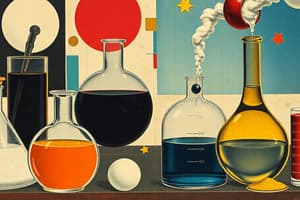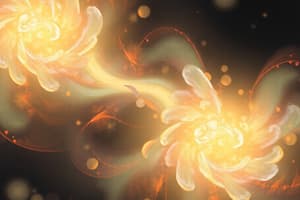Podcast
Questions and Answers
Which state of matter is characterized by particles that are widely separated with no defined structure?
Which state of matter is characterized by particles that are widely separated with no defined structure?
- Plasma
- Liquid
- Solid
- Gas (correct)
Which state of matter maintains its shape and has strong intermolecular forces?
Which state of matter maintains its shape and has strong intermolecular forces?
- Solid (correct)
- Gas
- Plasma
- Liquid
What is the fourth state of matter that occurs when a gas is exposed to an electric field or high temperatures?
What is the fourth state of matter that occurs when a gas is exposed to an electric field or high temperatures?
- Gas
- Liquid
- Plasma (correct)
- Solid
Which type of matter expands to fill any space it occupies?
Which type of matter expands to fill any space it occupies?
Which state of matter flows and takes on the shape of its container?
Which state of matter flows and takes on the shape of its container?
Flashcards are hidden until you start studying
Study Notes
States of Matter: Solid, Liquid, Gas, Plasma
States of matter refer to the physical condition of a substance under specific temperature and pressure conditions. There are four main states of matter, including solids, liquids, gases, and plasmas. Let's dive deeper into each state of matter and understand their unique properties.
Solids
Solids have a rigid structure and maintain their shape when subjected to an external force. They consist of particles that stay closely packed together due to strong intermolecular forces such as ionic, covalent, or metallic bonds. As temperature increases, molecules within solids vibrate more vigorously, eventually leading to melting and transitioning from a solid to a liquid state.
Examples of Solids
- Metals like gold and silver
- Glasses and ceramics
- Crystalline structures like table salt and sugar
- Dense materials like wood and marble
Liquids
Liquids are characterized by their ability to flow and take the shape of any container they are placed in. The particles of liquids are not as closely packed together as solids, and they can move freely past one another due to weak intermolecular forces such as van der Waals interactions or hydrogen bonding. As temperature increases further, molecules within liquids gain enough energy to break free from the liquid state entirely, transitioning into gases.
Examples of Liquids
- Water
- Oil
- Mercury
- Honey
Gases
Gases are characterized by their ability to expand and fill any container. They consist of particles that are widely separated with no defined structure, as the particles continually move around randomly due to high temperatures. These particles are far apart since there is little force holding them together other than weak intermolecular attractions between the particles.
Examples of Gases
- Air
- Helium
- Oxygen
- Steam (water vapor)
Plasma
Plasma is the fourth state of matter, which occurs when a gas is exposed to an electric field or has extremely high temperatures, causing its constituent electrons to become detached from the nuclei of atoms or molecules. The result is a partially ionized gas consisting primarily of charged particles called plasma.
Examples of Plasmas
- Neon signs
- Flame
- Solar wind
- Aurora borealis
In conclusion, states of matter play a crucial role in understanding how various substances behave under different conditions. Solids maintain their shape and have strong intermolecular forces, while liquids flow and take on the shape of their containers. Gases expand and fill any space, and plasmas are highly energetic forms of gases. Each state represents a unique set of properties that help us understand and interact with the world around us.
Studying That Suits You
Use AI to generate personalized quizzes and flashcards to suit your learning preferences.




